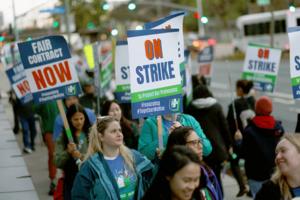Business
/ArcaMax

ServiceNow $12 billion deal spree is 'deja vu' of CEO's SAP says
After years of eschewing big mergers, ServiceNow Inc. is on a deal spree. It has spent at least $12 billion this year on acquisitions or strategic investments.
The action has some investors on edge about whether the software company is starting to lean on deals to spur growth, particularly given Chief Executive Officer Bill McDermott’s ...Read more

What is a robo-advisor? How it works, how much it costs, and pros and cons
Robo-advisors automate the investing process for you, making it simple to invest in a diversified portfolio of assets — and they cost much less than a typical financial advisor. It’s little wonder that many investors have turned to them, and robo-advisors now manage hundreds of billions of dollars.
What a robo-advisor does
A robo-advisor ...Read more

Washington's 'constantly squeezed' dairy farms find cheer in eggnog
LYNDEN, Whatcom County — More than 200 pairs of eyes turned to Larry Stap when he stepped into his dairy farm, Twin Brook Creamery, to check on the girls." Under the building's tin roof, a herd of curious Jersey cattle sheltered from the pelting rain on a December afternoon, crowding the edges of their pen to sniff newcomers.
It's eggnog ...Read more

Would you pay $12 for a cup of coffee in San Diego?
Your cortado, cold brew and tulip topped latte all cost a lot more than they did a few years ago.
As $2.25 espresso double shots increased to $4, San Diego coffee and espresso drinkers proved they are willing to pay more.
But how much more?
Talitha Coffee Roasters decided to ask its customers. The San Diego company, which sells wholesale ...Read more

Allison Schrager: 5 reasons to be optimistic about the 2026 economy
One year ago, businesses — especially CEOs — were optimistic about the U.S. economy in 2025, expecting lower taxes and more market-friendly policies from incoming President Donald Trump.
Then came April 2, Liberation Day. The market fell, uncertainty rose, and affordability became a more acute concern. Meanwhile, the labor market continued...Read more

Evan Ramstad: Even in 2025, you could put your money where your mouth is or heart lies
The most opined-about moment of the year on Minnesota’s business scene happened in January, when Target Corp. during Donald Trump’s inauguration week said it was ending some of its programs for improving diversity and inclusion.
I wrote at the time Target’s leaders were reading the zeitgeist, and Trump’s re-election had ended the virtue...Read more

Clive Crook: Investors are flying blind into the 'Golden Age'
Ten years ago I praised a book by Mervyn King, former governor of the Bank of England, on the subject of “radical uncertainty.” Back then, I agreed with King that radical uncertainty – the kind that statistical analysis can’t deal with – was a pressing issue for financial regulators. After the extraordinary year just ending, the ...Read more

Auto review: What I want for Christmas -- Porsche 911T manual
BRASELTON, Ga. — The bad news is the manual transmission is an endangered species these days as emissions regulations and electric vehicles have shrunk the options for American enthusiasts. The good news? Americans looooove to row the gearbox compared to their foreign peers (40% of VW GTI sales have been manual, just 5% in Europe), and so ...Read more

Auto review: 2025 Honda Prologue SUV is a win for EVs
Stacking up in Grasso’s Garage recently has been a slew of EV SUVs. From the EV9 by KIA and the newly redesigned fleet from Audi, EV’s are everywhere. As someone who is certain that vehicles should be hybrid’s and not fully electric, the Honda Prologues enters Grasso’s Garage and is changing my mind quickly.
The 2025 Honda Prologue ...Read more

Nevada files court brief in support of Maryland gaming fight
The Nevada attorney general’s office has filed a “friend of the court” brief on behalf of the state of Maryland in its continuing battle against prediction markets that are taking sports bets the state says are in violation of Nevada gaming laws.
Nevada Attorney General Aaron Ford on Monday formally filed a 49-page amicus brief co-...Read more

Google is at last letting users swap out embarrassing Gmail addresses without losing their data
Google has finally answered users' cries, allowing Gmail users to swap out embarrassing teenage email addresses.
Gmail account holders can now change their existing @gmail.com address while retaining their data and services.
Once changed, old email addresses will remain active, and users will continue to receive emails sent to both the old and...Read more

After leaving ULA, Tory Bruno heads to Blue Origin
Earlier this week United Launch Alliance announced its president and CEO for nearly 12 years, Tory Bruno, was stepping down to pursue different opportunities.
The opportunity was revealed Friday as Bruno was named president for competitor Blue Origin’s newly formed National Security Group, reporting to Blue Origin CEO Dave Limp.
“We share ...Read more

Gold and silver smash records again as rally gathers momentum
Gold, silver and platinum jumped to all-time highs to extend a historic end-of-year rally for precious metals, with support from escalating geopolitical tensions, U.S. dollar weakness and thin market liquidity.
Spot gold rose as much as 1.2% to a peak above $4,530 an ounce on Friday. Spot silver for immediate delivery advanced for a fifth ...Read more

Stocks hover near record as Nvidia gains on AI licensing deal
U.S. stocks wavered near a record high in thin holiday trading, as yields on 10-year Treasuries bounced and investors shifted attention toward commodities. Nvidia Corp. climbed as analysts viewed a licensing deal with artificial intelligence startup Groq positively.
The S&P 500 and the Nasdaq 100 were both trading little changed at 12:32 p.m. ...Read more

Kaiser labor talks stall, raising fears of another strike
SAN JOSE, Calif. — Talks between Kaiser and a labor union representing health care workers ground to a halt late last week, raising concerns about another strike at California’s largest health care provider.
The union representing 31,000 Kaiser workers statewide — including about 2,000 rehab therapists, physician assistants, nurse ...Read more

They graduated from Stanford. Due to AI, they can't find a job
A Stanford software engineering degree used to be a golden ticket. Artificial intelligence has devalued it to bronze, recent graduates say.
The elite students are shocked by the lack of job offers as they finish studies at what is often ranked as the top university in America.
When they were freshmen, ChatGPT hadn't yet been released upon the ...Read more

Casey Williams: Whither the 'hot hatch' in the age of electric motoring?
It’s noon, and I’m sitting in Jackson, Tennessee, a waypoint on Interstate 40 an hour east of Memphis. My husband calls and wants to know if I’ll be home in Indianapolis for dinner. I look at the Volkswagen GTI while knowing there are hours of challenging roads ahead.
“Yeah, I’ll be there,” I said. I threw my bags under the hatch, ...Read more

Larry Printz: The top 10 test drives of 2025
For many people, automobiles serve a purely utilitarian purpose. They are a means of transportation, a necessity, and little more than a recurring expense. Yet for most of us, they are far more than that. In their design, one glimpses human aspiration; in their performance, a promise of escape. Behind the wheel, anxieties are momentarily left ...Read more

Henry Payne: The best auto features of 2025
Automobiles are rolling department stores containing everything from electronics to music to tires to wardrobe fashion. Wardrobe fashion? Check out the stylish blue leather seats in the Cadillac Optiq.
This year brought more cool features to keep the shoppers coming.
One feature I didn’t care for? The warning gong — BEEP BEEP BEEP — in ...Read more

Hack of Aflac potentially affected more than 22 million people, company says
A cybersecurity breach of Columbus, Georgia-based insurance giant Aflac Inc. potentially exposed the personal information of approximately 22.65 million people, the company said in a statement last week.
The affected files included names, contact information, claims information, health information, Social Security numbers, and/or other personal...Read more
Popular Stories
- ServiceNow $12 billion deal spree is 'deja vu' of CEO's SAP says
- Would you pay $12 for a cup of coffee in San Diego?
- Washington's 'constantly squeezed' dairy farms find cheer in eggnog
- What is a robo-advisor? How it works, how much it costs, and pros and cons
- Allison Schrager: 5 reasons to be optimistic about the 2026 economy









